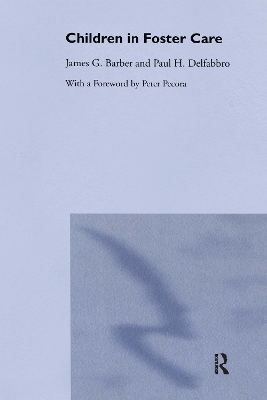
Children in Foster Care
Seiten
2003
Routledge (Verlag)
978-0-415-31164-9 (ISBN)
Routledge (Verlag)
978-0-415-31164-9 (ISBN)
- Titel z.Zt. nicht lieferbar
- Versandkostenfrei innerhalb Deutschlands
- Auch auf Rechnung
- Verfügbarkeit in der Filiale vor Ort prüfen
- Artikel merken
As child welfare increasingly enters a world of research-based practice Children in Foster Care provides some much needed hard evidence of how foster care policy and practice can be improved.
Researchers, practitioners, journalists and politicians increasingly recognise that foster care throughout the world is in a state of crisis. There are more and more children needing care and, as residential alternatives dry up, more of these children are being assigned to foster families. This book reports the major findings of a two-year longitudinal study of 235 such children who entered the foster care system in Southern Australia between 1998 and 1999. As well as examining the changing policy context of children's services, the book documents the psychosocial outcomes for these children, their feedback on their experiences of care, and the views of their social workers and carers. In the process, the book examines some cherished beliefs about foster care policy and sheds new light on them.
The research reveals that while most children do quite well in foster care up to the two-year point, there is a worrying amount of placement instability at a time when the concentration of emotionally troubled children in care is increasing throughout the western world. Although, surprisingly, placement instability does not appear to produce psychosocial impairment for a period of up to eight months in care, it has an extreme effect on children who are moved from placement to placement because no carer will tolerate their behaviour. These children are consigned to a life of distribution and emotional upheaval because of the lack of alternative forms of care. Another unexpected finding of the research is that increasing the rate of parental contact achieves little or nothing in relation to the likelihood of family reunification.
As child welfare increasingly enters a world of research-based practice, Children in Foster Care provides some much needed hard evidence of how foster care policy and practice can be improved.
Researchers, practitioners, journalists and politicians increasingly recognise that foster care throughout the world is in a state of crisis. There are more and more children needing care and, as residential alternatives dry up, more of these children are being assigned to foster families. This book reports the major findings of a two-year longitudinal study of 235 such children who entered the foster care system in Southern Australia between 1998 and 1999. As well as examining the changing policy context of children's services, the book documents the psychosocial outcomes for these children, their feedback on their experiences of care, and the views of their social workers and carers. In the process, the book examines some cherished beliefs about foster care policy and sheds new light on them.
The research reveals that while most children do quite well in foster care up to the two-year point, there is a worrying amount of placement instability at a time when the concentration of emotionally troubled children in care is increasing throughout the western world. Although, surprisingly, placement instability does not appear to produce psychosocial impairment for a period of up to eight months in care, it has an extreme effect on children who are moved from placement to placement because no carer will tolerate their behaviour. These children are consigned to a life of distribution and emotional upheaval because of the lack of alternative forms of care. Another unexpected finding of the research is that increasing the rate of parental contact achieves little or nothing in relation to the likelihood of family reunification.
As child welfare increasingly enters a world of research-based practice, Children in Foster Care provides some much needed hard evidence of how foster care policy and practice can be improved.
James Barber, Paul Delfabbro, Robyn Gilbertson
Section One: An introduction to Foster Care 1. Assessment, Planning and Intake 2. In-Care Standards Secton Two: Backgrouund to the Study 3. From Parent to Purchaser: The new Policy Context 4. Methodology Section Three: Results 5. The Views of Workers and Carers on Outsourced Care 6. Background Characteristics of Children Entering Care 7. The Progress and Satisfaction of Children in Care 8. How Important is Family Contact? 9. The Predictions of Family Reunification 10. The Psychosocial Consequences of Placement Instability 11. The Serial Eviction of Disruptive Children 12. The Views of Disruptive Children and their Carers 13. Myths and Legends in Foster Care
| Erscheint lt. Verlag | 18.12.2003 |
|---|---|
| Verlagsort | London |
| Sprache | englisch |
| Maße | 156 x 234 mm |
| Gewicht | 476 g |
| Themenwelt | Sozialwissenschaften ► Pädagogik ► Sozialpädagogik |
| Sozialwissenschaften ► Soziologie ► Makrosoziologie | |
| ISBN-10 | 0-415-31164-0 / 0415311640 |
| ISBN-13 | 978-0-415-31164-9 / 9780415311649 |
| Zustand | Neuware |
| Informationen gemäß Produktsicherheitsverordnung (GPSR) | |
| Haben Sie eine Frage zum Produkt? |
Mehr entdecken
aus dem Bereich
aus dem Bereich
Grundlagen - Konzepte - Methoden
Buch | Softcover (2023)
Kohlhammer (Verlag)
34,00 €
Handbuch zur Prävention und Intervention
Buch | Hardcover (2024)
mebes & noack (Verlag)
24,00 €
ein Lehrbuch zum Kita-Management
Buch | Softcover (2023)
Kohlhammer (Verlag)
46,00 €


